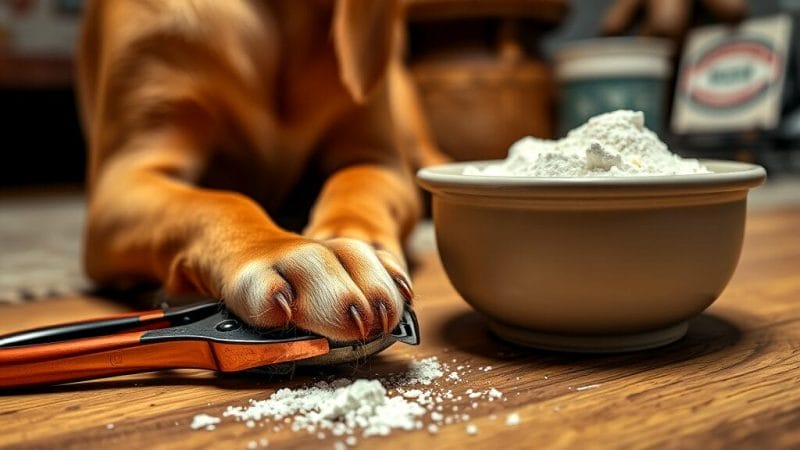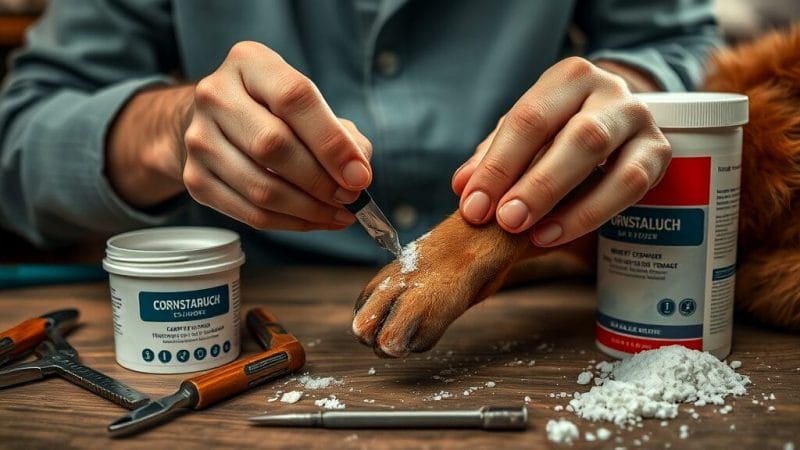How To Stop A Dog’s Nail From Bleeding Home Remedy

Trimming your dog’s nails can sometimes feel like walking a tightrope. One slip, and you might find yourself dealing with dog nail bleeding. It happens to the best of us, but don’t fret! There are simple home remedies to stop the bleeding. A mix of cornstarch and baking soda works wonders when you don’t have styptic powder handy. Just dip the bleeding nail into the mix, and voilà! Understanding nail anatomy can prevent future mishaps for those who regularly perform dog nail trims.
And if you’re considering it, having pet insurance like Embrace can provide peace of mind for unexpected veterinary visits. Keep dog nail clippers ready, and remember that practice makes mastering dog nail trimming perfect!

The Importance of Proper Dog Nail Trimming
Understanding the significance of trimming your dog’s nails helps prevent injuries. Nails that grow too long can cause discomfort or lead to dog nail injuries. Keeping nails at a healthy length reduces the risk of a bleeding nail during trims. Knowing how to stop dog nail bleeding during trimming is crucial if an accident occurs. Using styptic powder or cornstarch can quickly stop dog nail bleeding. Consider investing in a quality dog nail clipper to make the process easier.
Recognizing the Anatomy of a Dog’s Nail
Understanding your dog’s nail structure is key. Each nail has the “quick,” a sensitive spot with blood vessels. In lighter nails, it’s visible, making it easier to avoid. This knowledge helps prevent any unwanted bleeding during trims. Stop dog nail bleeding by applying pressure and using a styptic powder. If you lack this, cornstarch can do the trick. Keeping your furry buddy calm during this process is also important. Consider embracing pet insurance for those unexpected vet bills.
Common Causes of Dog Nail Injuries
The causes of nail troubles vary. Cutting nails too close leads to dog nail bleeding. Playtime accidents and overgrown nails are also culprits. Sometimes, medical issues like infections or weak nails cause injuries. Nail trimming without the right tools increases risk. Damaged nails upset dogs and owners alike. Consider these pointers:
Trim regularly.
Use sharp, reliable clippers.
Avoid cutting too close.
Check for hidden injuries.
Monitor for splits or cracks.
Use styptic powder for bleeding.
Invest in pet insurance like Embrace.
What Happens When a Dog’s Nail Bleeds?
When a dog’s nail starts bleeding, it can be distressing for the pet and the owner. You might see blood, hear whining, or notice limping. Calm your dog with soothing words. Address the bleeding nail quickly. Apply pressure with a cloth or use styptic powder for immediate relief. If you want to know more about dog toenail anatomy, Toegrips provides excellent insights here. If bleeding continues, contact a vet. Regular care helps prevent future dog nail injuries.
Identifying Signs of a Bleeding Nail
Spotting a bleeding nail isn’t rocket science. Look for visible blood, your dog limping, or constant licking. Sometimes, swelling or an obvious wound around the nail gives it away. These signs scream for urgent attention to avoid complications. Swift action is key. Calm your pup and reach for some styptic powder to stop the mess. If things don’t improve, a vet visit might be needed. Regularly checking your dog’s nails helps make you happy and mess-free.
How Long Will a Dog’s Nail Bleed?
How long might a dog’s nail continue to bleed? Typically, bleeding stops within two to four minutes with the right care. The worst-case scenario might stretch to 20-30 minutes. If this happens, it’s time to chat with the vet. Applying pressure is crucial, but styptic powder can be a game-changer. Keeping an eye on the situation helps ensure the bleeding doesn’t become a bigger issue. Stay calm, reassure your dog, and everything should come up roses quickly.
Immediate Actions to Take for a Bleeding Nail
Addressing a bleeding dog nail requires quick action. Begin by staying calm to reassure your pet. Gently apply pressure to the nail using a clean cloth for about two minutes. If available, use styptic powder to stop the bleeding quickly. This can be a real lifesaver when the cut is too close. For those without it, cornstarch or baking soda can serve as substitutes. Contacting a vet is advisable if the situation doesn’t improve within 20 minutes.
Staying Calm: The Owner’s Role
Keeping a cool head can make all the difference. When you stay calm, your dog feels secure. It’s like turning chaos into a peaceful walk in the park. Offer gentle words and a treat or two. This helps stop dog nail bleeding during trimming by reducing stress. You become their anchor, calming the storm. Need a tip? Keep dog nail clippers handy, and always have a plan. Your prepared demeanor ensures smooth sailing through any minor mishap.
Applying Pressure to the Wound
Applying consistent pressure to the wound can halt dog nail bleeding during trimming. Gently press a clean cloth against the bleeding area for two solid minutes. This simple act works wonders by minimizing blood flow. If the bleeding nail shows no sign of stopping, consider using an alternative remedy like cornstarch. It’s a nifty trick! If bleeding persists beyond 20 minutes, consult a vet. Embrace pet insurance for peace of mind in such unexpected situations.
Use of Styptic Powder in Dog Nail Bleeding
Using a powder to stop nail bleeding in dogs is like having a magic wand. Just dip the nail into the powder, apply it with a swab, and hold it for 30 seconds. It stops the bleeding quickly. If you run out, cornstarch or baking soda can pinch-hit. Applying the right tool ensures smooth sailing during nail trimming, minimizing mishaps and keeping tails wagging.

How to Apply Styptic Powder Correctly
Using a powder to halt nail bleeding is a breeze. Gently dip the affected nail into the powder or apply it with a swab. Hold for 30 seconds to ensure proper coagulation. If you’re out of powder, don’t worry—cornstarch or baking soda can step in. This simple trick can effectively stop dog nail bleeding during trimming. Remember, if the bleeding persists beyond the usual timeframe, embrace pet insurance for peace of mind and consult your vet.
Cleaning and Bandaging Your Dog’s Wound
Ensuring your pup’s wound is clean before bandaging is crucial. Rinse with lukewarm water and mild soap. Pat dry with a soft towel. Once dry, wrap a bandage snugly but not too tight. This keeps out pesky germs and prevents licking. Keep an eye on it to ensure it stays dry and secure.
Importance of Keeping the Wound Clean
Maintaining a clean wound is like giving it a fresh start. After stopping the bleeding, gently wash the nail with lukewarm water and mild soap. This keeps infections at bay, ensuring a smooth healing process. Dry it well, and don’t skimp on the bandage; it’s your guard against dirt. Think of it as a protective shield. Your pup might resist, but a clean wound is a happy one. With these steps, you’re making sure your dog recovers swiftly.
5 Ways to Prevent Future Dog Nail Injuries
Learning how to prevent nail issues can be crucial for your dog’s well-being. Consider these tips:
Regular trimming at home can keep those nails at a safe length.
Use high-quality nail trimming tools to ensure a smooth cut.
Train your dog to remain calm and comfortable during the process.
Inspect nails frequently for damage or growth.
Give plenty of exercise to wear nails naturally.
Understanding how to stop nail bleeding during trimming is also essential. If you accidentally clip too much, applying pressure or using a home remedy like cornstarch can help.
When to Seek Professional Veterinary Care
Consult a vet if nail bleeding persists beyond 30 minutes or infection symptoms appear. Professional advice might be necessary if your pet shows discomfort or unusual behavior. Professional grooming ensures proper nail trimming for regular maintenance and prevents future issues. It’s a great way to avoid mishaps and keep your pet’s paws in shape. Regular check-ups and cleanings can also detect other underlying problems early. So, don’t hesitate to reach out to a vet when needed!
